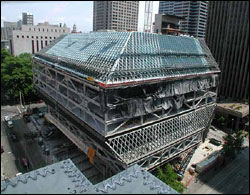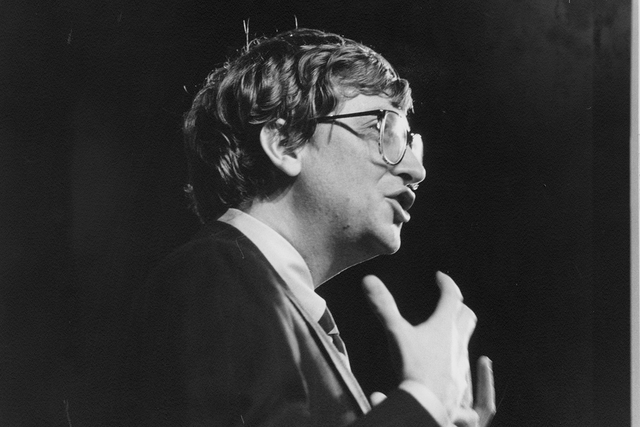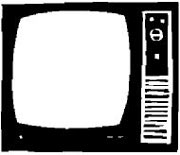MOVING DAYS CAN be dangerous times for libraries and for the books they shelter and share. The logistics of transferring hundreds of thousands of cataloged items are daunting, especially when, as in Seattle, a library must move twice, first to temporary quarters and then to a new building on its old site. They can be frustrating for patrons who discover the volumes they need are buried in deep storage. And they can be scary for patrons and librarians alarmed at what the novelist-turned-archival activist Nicholson Baker calls “the assault on paper” undertaken by digital-struck modern libraries.
IN 1996, BAKER SET the library world on its ear when he revealed that San Francisco’s imposing and much-touted new main library could hold 170,000 fewer books than the oldand the misfits were being surreptitiously dumped. Library supporters howled at the betrayal and the city librarian resigned. No such scandals loom over the opening, now scheduled for next spring, of Seattle’s even-more-imposing new downtown library, by überarchitect Rem Koolhaas. It will have room for half a million more books than its 900,000-volume predecessor. And where most of the old collection was packed away in closed stacks, Koolhaas’ design puts nearly everything on public shelvesfor better and, maybe, worse. (More access means more theft and damage, which some librarians fear will discourage the acquisition of scarce and specialized materials.)
Despite the ample space and architectural buzz, library veterans have awaited the move uneasily, fearing that irreplaceable but cumbersome paper holdings might be cleaned out now and missed later. Their fears derive in part from ongoing initiatives to streamline and consolidate acquisitions. Book selection has been relegated from subject librarians to a central collections office. Dowdy and tired-looking tomes are being aggressively weeded out. Traditional subjects will be consolidated in superdepartments such as “Arts, Literature, and Recreation,” merging turfs and perhaps also diluting specialties.
Librarians can no longer acquire gifts and lucky finds from used bookstores and other offbeat sourcesexcept on what technical and collection services director Lois Fenker calls “rare occasions, if someone has some highly specialized or otherwise unobtainable volume.” Fenker correctly notes that “much of what’s donated clearly isn’t suitable for the collection.” And such one-off acquisitions entail extra labor costs, such as adding barcodes and jackets that outside selection services ordinarily provide in bulk. But librarians drool helplessly over treasures donated to the Friends of the Library book sales and lament letting gaps in the collection go begging when they could fill them for a song. “It’s frustrating,” says one. “There’s no way now to acquire older or out-of-print books.”
THE UPSHOT SHOULD be greater efficiency and brighter, more-inviting shelves; specialists fear it will also mean a more shallow, generic collection, less attuned to local needs and idiosyncrasies. But they can take heart from the decisions on several unusual arts-related collections in the downtown library that don’t fit the bright-and-shiny-shelves scheme, whose days had seemed numbered. One is the “Play File,” some 5,500 stage-version scripts, a boon for schools and theaters. Arts, Recreation, and Literature Department manager Jodee Fenton concedes that some “what if” discussions about scrapping the Play File did take place but declares, “It will definitely be in the new library.” Not only that, the plays will move out of dreary file cabinets into spiffy custom bins, and a custom-made on-line index of casting combinations will help stage groups use them.
LOCAL ILLUSTRATORS and researchers have long trembled at rumors of doom for the vast, century-old “Picture File,” one of the few such graphic and historic archives still maintained in public libraries. But Fenton affirms that it too will move, intact, to the new quarters, and its 19 file cabinets will be seeded into appropriate subject areas in the book sequence for readier access. (At the same time, performance tapes and discsoperas, plays, etc.which have been interfiled with their print counterparts will be pulled out and shelved together. That makes sense; when you want a video, you don’t want to hunt through the whole book collection.)
Fenton says the library’s sheet-music collections and its files of scrapbooks, clips, and other regional arts memorabilia will also make it to the new digs. Another collection will be scrapped, however: lending posters that have grown tattered and dated over the years. Again, that makes sense; people don’t check out Monet prints for their walls the way they used to, and Fenton says that archival postersgoing back to World War Iwill be preserved.
These reassuring choices suggest that architectural and technological razzle-dazzle haven’t blinded Seattle’s library to the legacy it safeguards and the many needs it serves. But the proof will be in the shelving.








